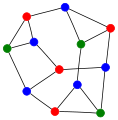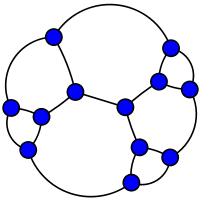Frucht graph
| Frucht graph | |
|---|---|
|
The Frucht graph | |
| Named after | Robert Frucht |
| Vertices | 12 |
| Edges | 18 |
| Radius | 3 |
| Diameter | 4 |
| Girth | 3 |
| Automorphisms | 1 ({id}) |
| Chromatic number | 3 |
| Chromatic index | 3 |
| Properties |
Cubic Planar Hamiltonian |
In the mathematical field of graph theory, the Frucht graph is a 3-regular graph with 12 vertices, 18 edges, and no nontrivial symmetries.[1] It was first described by Robert Frucht in 1939.[2]
The Frucht graph is a Halin graph with chromatic number 3, chromatic index 3, radius 3, diameter 4 and girth 3. As with every Halin graph, the Frucht graph is planar, 3-vertex-connected, and polyhedral. It is also a 3-edge-connected graph. Its independence number is 5.
The Frucht graph is Hamiltonian and can be constructed from the LCF notation: [−5,−2,−4,2,5,−2,2,5,−2,−5,4,2].
Algebraic properties
The Frucht graph is one of the two smallest cubic graphs possessing only a single graph automorphism, the identity[3] (that is, every vertex can be distinguished topologically from every other vertex). Such graphs are called asymmetric (or identity) graphs. Frucht's theorem states that any group can be realized as the group of symmetries of a graph,[2] and a strengthening of this theorem also due to Frucht states that any group can be realized as the symmetries of a 3-regular graph;[4] the Frucht graph provides an example of this realization for the trivial group.
The characteristic polynomial of the Frucht graph is  .
.
Gallery
-

The chromatic number of the Frucht graph is 3.
-

The Frucht graph is Hamiltonian.
See also
| Wikimedia Commons has media related to Frucht graph. |
References
- ↑ Weisstein, Eric W., "Frucht Graph", MathWorld.
- ↑ 2.0 2.1 Frucht, R. (1939), "Herstellung von Graphen mit vorgegebener abstrakter Gruppe.", Compositio Mathematica (in German) 6: 239–250, ISSN 0010-437X, Zbl 0020.07804.
- ↑ Skiena, S. Implementing Discrete Mathematics: Combinatorics and Graph Theory with Mathematica. Reading, MA: Addison-Wesley, 1990
- ↑ Frucht, R. (1949), "Graphs of degree three with a given abstract group", Canadian Journal of Mathematics 1: 365–378, doi:10.4153/CJM-1949-033-6, ISSN 0008-414X, MR 0032987.
